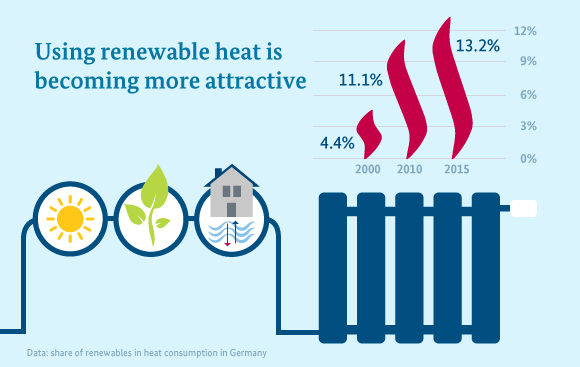Renewable heat on the rise
Using renewable energy for heating is becoming more attractive: In 2015, renewables such as solar, biomass and ambient heat accounted for more than 13 per cent of heat consumption in Germany – setting a new record.
 © BMWi; data provided by the Working Group on Renewable Energy Statistics
© BMWi; data provided by the Working Group on Renewable Energy Statistics
More and more people are using the sun to heat their homes in winter. In 2015, renewables accounted for 13 per cent of the energy used for heating and cooling. This means that we have come a long way in reaching the Federal Government’s target of more than 14 per cent by 2020.
Use the sun to heat your home in winter
According to the latest figures presented by the Working Group on Renewable Energy Statistics, renewable energy is becoming more important, not only for generating electricity, but also for generating heat. In 2015, the share of renewables in Germany’s heat consumption reached 13.2 per cent, compared to 12.5 per cent the previous year. Back in 2010, it was just around 11.1 per cent – which, however, is considerably up from figures in 2000, when renewables only accounted for 4.4 per cent of heat consumption.
In 2015, the temperatures were lower on average than in 2014, which is why total heat consumption slightly increased, reaching an estimated 1,176 billion kilowatt-hours (kWh) compared to 1,167 billion kilowatt-hours the previous year. The good news is that the share of renewable heat also rose over this same time period – an increase of 6.5 per cent over the previous year. In 2014, 145 billion kilowatt-hours of renewable heat were generated. In 2015, it was 155 billion kilowatt-hours. Why this significant increase?
The use of woodchips, solar thermal energy and ambient heat is rising
The number of new types of heating systems that are used in Germany is growing. For example, we are seeing that the use of solar thermal energy, heat pumps and biomass for heating purposes is continuing to rise. The use of wood chips – wood that is shredded and then compressed to create cylindrical pieces – slightly increased from 1.8 million tonnes to 1.85 million tonnes between 2014 and 2015. One reason for this is that the use of pellet-burning systems has increased. In 2015, another 32,000 pellet-burning systems were added, reaching a total of 390,500. Some 257,000 of these were central heating systems.
The Market Incentive Programme makes changing to renewable heat worth your while
Despite positive developments, the share of solar thermal energy, biomass and ambient heat in space and water heating is still not as large as it could be. This is bound to change. The Market Incentive Programme for the Use of Renewable Energy in the Heating Market, for example, now makes the use of renewable heat even more attractive. The programme aims to encourage home owners, companies and municipalities to opt for solar thermal energy, biomass and ambient heat to meet their heating needs.
New funding available
Last year, the terms and conditions for claiming funding under the Market Incentive Programme were improved once more. At the beginning of 2016, the Energy Efficiency Incentive Programme was launched. Additional incentives are provided to encourage people to abandon fossil-fuel-based heating systems that are outdated and upgrade to renewables. For example, whenever people not only replace their old heating with a new one, but also optimise their entire heating system, they will receive an additional 20 per cent in funding under the Market Incentive Programme.

